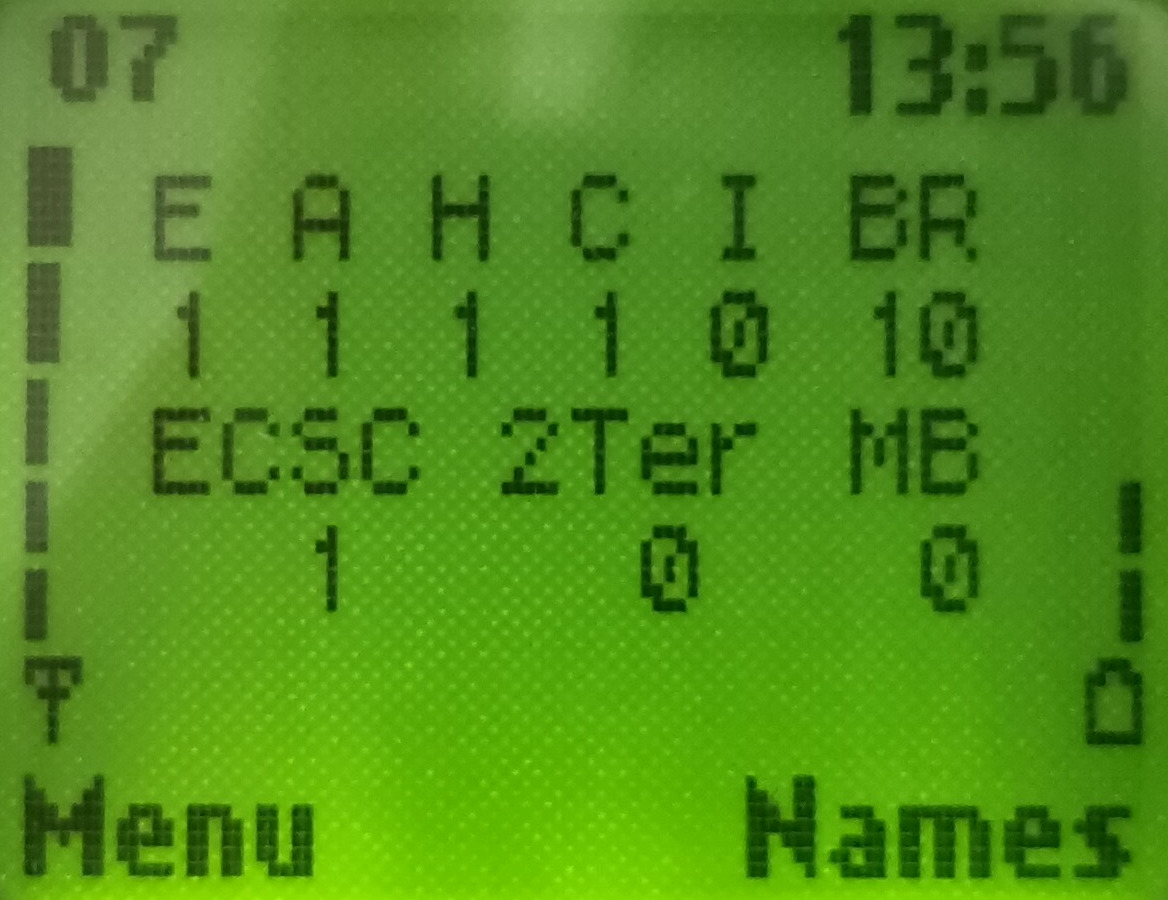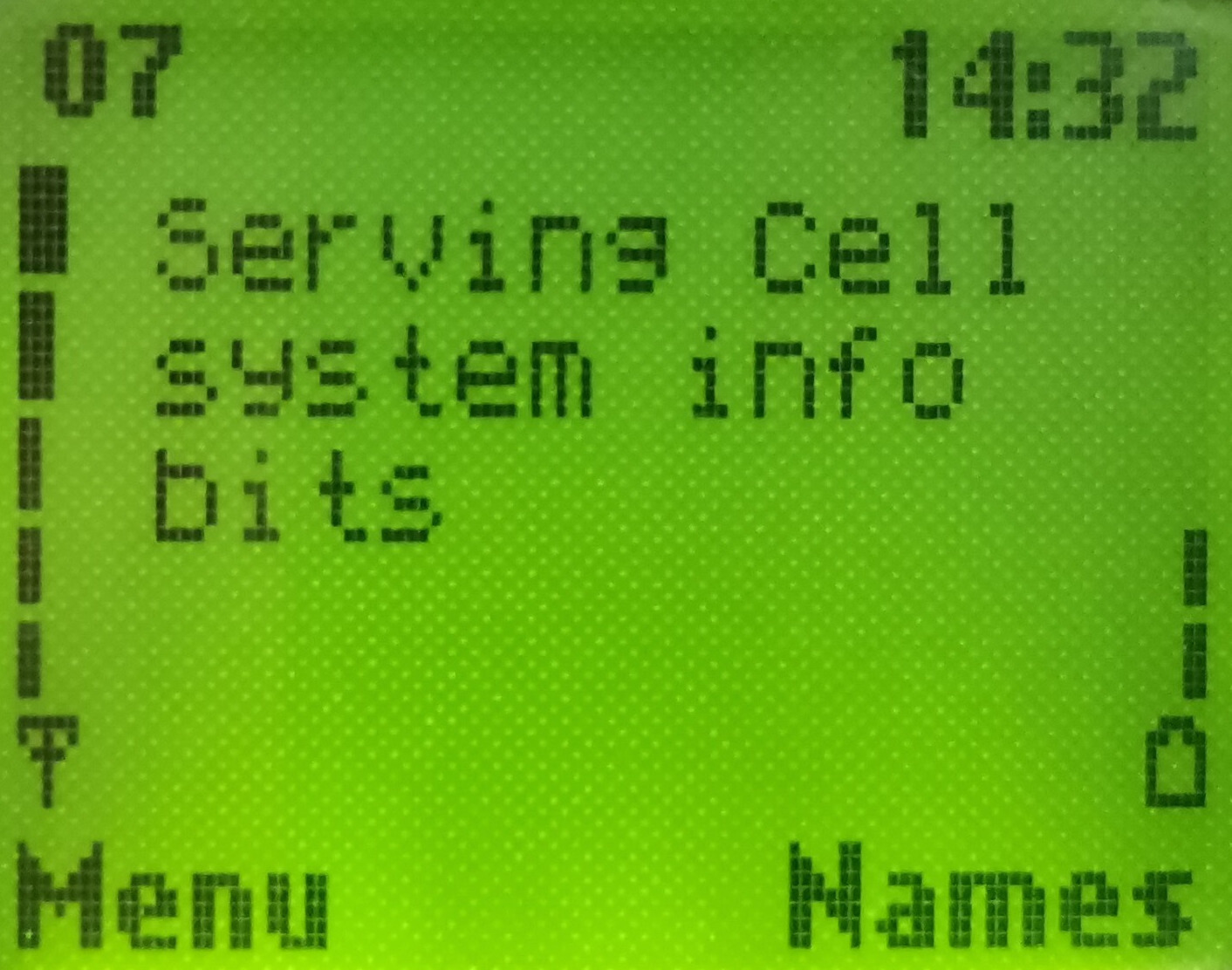Main page
News
Guest book
Home bs0dd.net
Phones
List of modelsFirmware
Net Monitor
FT/NM activationNet Monitor (DCT3)
Net Monitor (DCT4)
Soft and games
Java MIDletsOfficial soft
Soft for 5510
PC software
Connectivity
Data-CablesFLOSYS FBUS/MBUS docs
DLR-3 MBUS (atrox)
Modding
Color display (6310)Soft for DCT3 modding
WAP
WAP-gatewayWAP-page
Other
Nokia 9210 archiveElektronika MK
Kannel for Windows
Nokia Net Monitor description (DCT3)
MAIN PAGE
< PREVIOUS PAGE
NEXT PAGE >
Test 07 – Current Cell Flags
Available in: 2100, 3330, 5110, 6150, 6210, 7110, 8210, 8250
This test displays values about the network and current cell, obtained from the current BTS.
| Test screen | Help screen |
 |
 |
Note the lower half of the display (ECSC, 2Ter, MB) only appears on dualband phones.
E: The network allows emergency calls through 112 are possible, regardless of authentication – this information is broadcast in System Information Type 1, 2, 2bis messages.A: The IMSI-attach-detach procedure is to be used. IMSI- attach is where the phone sends a special location update to the network when it is powered up (or returns to the coverage area) (under certain conditions) to inform the network it is ready to take calls. IMSI-detach is where the phone informs the network it is not available to take calls (i.e. it may be turning off). It is like a logon/logoff, so the network doesn’t bother trying to search for the phone and the caller immediately gets your voicemail or not available message. This information is broadcast in System Information Type 3 messages. [GSM 04.08:4.3.4, 4.4.3]
H: The value of the NECI bit. The NECI bit decides whether the Phase 2 MS shall use the new establishment cause values (8-bit values) when sending a CHANNEL REQUEST on the RACH. The new establishment causes provide the network with more information about what the MS intends to do with the connection. Phase 1 networks always have the NECI bit set to 0. Most of the new establishment causes are related to TCH/H (half-rate) channel requests, this is why this field is labelled as “Half Rate Support”. [GSM 04.08:9.1.8]
C: C2 values are supported by the network. [GSM 05.08:6.4]
I: System Information Messages 7 and 8 are broadcast by the cell. System information 7 and 8 messages contain the extra cell selection parameters (such as CELL_RESELECT_OFFSET, TEMPORARY_OFFSET, see “Test 1 – Serving Cell Information (1)”). These parameters are broadcast on the BCCH Ext, which is an additional downlink channel obtained by taking away blocks normally used for paging(PCH)/access grant(AGCH). These parameters may also be broadcast in System Information type 4 messages.
B: The network supports Cell Broadcast SMS Messages. This information is broadcast in System Information Type 4 messages. [GSM 04.12]
R: The network supports call-re-establishment – this is where the phone attempts to automatically re-establish the connection after a radio link failure. This information is broadcast in System Information Type 1, 2, 2bis messages. [GSM 04.08:4.5.1.6]
ECSC: Early Classmark (ECSC) is supported. ECSC is where the mobile station attempts to send a classmark (it’s capabilities) to the network as early as possible. This classmark may include power output, encryption, SMS, revision level (see “Test 44 – Change Revision Level value”), SS Screening indicator (see “Test 14 – Change Screening Indicator value”), and other information. This flag only displays during idle mode. In dedicated mode (call) this displays ‘x’. This information is broadcast in System Information type 3 messages. [GSM 04.08:3.3.1.1.4.1,10.5.1.5,10.5.1.6,10.5.1.7]
2Ter: System Information type 2Ter messages are supported. This flag only displays during idle mode. In dedicated mode (call) this displays ‘x’. 2Ter messages contain information to help the MS find neighbour cells BCCH carrier channels, possibly in multiple bands. [GSM 04.08:9.1.34]
MB: A value from 0-3 which decides how the dualband MS (phone) will report the 6 other cells to the network, value is broadcast in System Information type 2Ter message (see above). [GSM 05.08:8.4.3]
According to the GSM Specifications [GSM 05.08:8.4.3]:
- If the value is 0 the MS reports the six strongest cells whose NCC (Network Color Code) component of the BSIC (Base Station Identifying Code) is allowed (i.e. usually means part of the same network). The cells can be across any band.
- If the value is 1 the MS reports the strongest cell in each of the bands excluding the band of the serving cell. The remaining positions in the report are used to monitor the strongest cells in the band of the serving cell. If there are any leftover positions, they are filled with remaining strongest cells from any band.
- If the value is 2 the MS reports the 2 strongest cells in each of the bands excluding the band of the serving cell. The remaining positions are filled with the strongest cells of the band of the serving cell. Any leftover positions are filled with the remaining strongest cells in any band.
- If the value is 3 the MS behaves in exactly the same way as if the value was 2, however it reports the 3 strongest cells in the bands excluding the serving cell’s band.
When the term ‘bands’ is used in the above description, it is referring to the allowed blocks of spectrum broadcast by the cell in the BCCH/SACCH, known as the BA (BCCH Allocation).
In dedicated mode, you can see the contents of the measurement report in Tests 3, 4, and 5, and how this parameter affects the contents.
In the example screen, my serving cell supports emergency calls, IMSI-attach-detach procedure, NECI, C2 values, cell broadcasts and ECSC.
Port: 9201
Переключиться на Русский
Powered by COMPPAG 0.56
2022-2025 © Compys S&N Systems